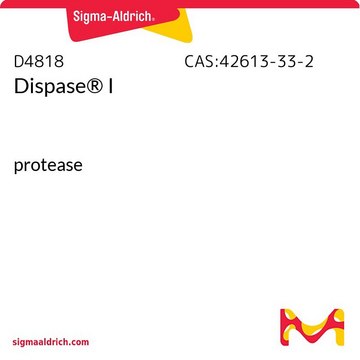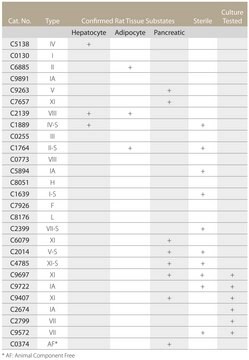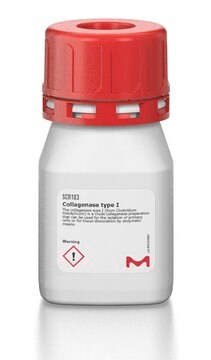D4693
Dispase® II
protease
Synonim(y):
Protease from Bacillus polymyxa
About This Item
Polecane produkty
Poziom jakości
Formularz
lyophilized solid
aktywność właściwa
≥0.5 units/mg solid
metody
cell culture | mammalian: suitable
single cell analysis: suitable
rozpuszczalność
10 mM NaAc (pH 7.5) and 5 mM CaAc: soluble
temp. przechowywania
2-8°C
Szukasz podobnych produktów? Odwiedź Przewodnik dotyczący porównywania produktów
Zastosowanie
Dispase® II has been used for Fluorescence-Activated Cell Sorting (FACS). It has also been used for separating visceral yolk sac layers.
Suitable for use in preparation of single cell suspension for sequencing.
Działania biochem./fizjol.
Definicja jednostki
Postać fizyczna
Uwaga dotycząca przygotowania
Komentarz do analizy
Informacje prawne
Hasło ostrzegawcze
Danger
Zwroty wskazujące rodzaj zagrożenia
Zwroty wskazujące środki ostrożności
Klasyfikacja zagrożeń
Eye Irrit. 2 - Resp. Sens. 1 - Skin Irrit. 2 - STOT SE 3
Organy docelowe
Respiratory system
Kod klasy składowania
11 - Combustible Solids
Klasa zagrożenia wodnego (WGK)
WGK 3
Temperatura zapłonu (°F)
Not applicable
Temperatura zapłonu (°C)
Not applicable
Wybierz jedną z najnowszych wersji:
Masz już ten produkt?
Dokumenty związane z niedawno zakupionymi produktami zostały zamieszczone w Bibliotece dokumentów.
Klienci oglądali również te produkty
Produkty
Enzyme Explorer Key Resource: Collagenase Guide.Collagenases, enzymes that break down the native collagen that holds animal tissues together, are made by a variety of microorganisms and by many different animal cells.
Zastosowanie oligos modyfikowanych lipidami MULTI-seq, protokół i przewodnik rozwiązywania problemów dla testów PCR i aplikacji sekwencjonowania.
rganoid culture products to generate tissue and stem cell derived 3D brain, intestinal, gut, lung and cancer tumor organoid models.
Produkty do hodowli organoidalnej do generowania trójwymiarowych modeli mózgu, jelit, jelit, płuc i guzów nowotworowych pochodzących z tkanek i komórek macierzystych.
Powiązane treści
Kolagenazy, enzymy rozkładające natywny kolagen, który utrzymuje tkanki zwierzęce razem, są wytwarzane przez różne mikroorganizmy i wiele różnych komórek zwierzęcych.
Nasz zespół naukowców ma doświadczenie we wszystkich obszarach badań, w tym w naukach przyrodniczych, materiałoznawstwie, syntezie chemicznej, chromatografii, analityce i wielu innych dziedzinach.
Skontaktuj się z zespołem ds. pomocy technicznej









